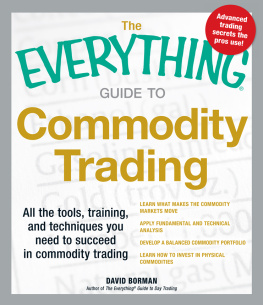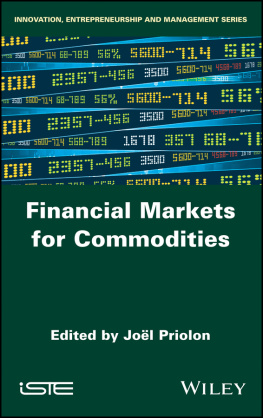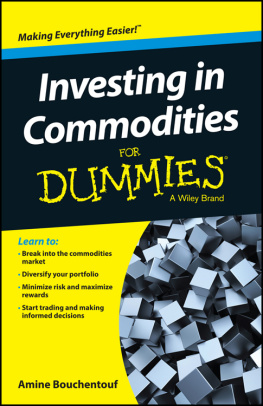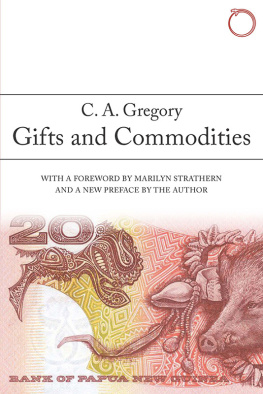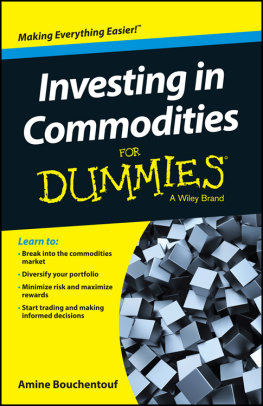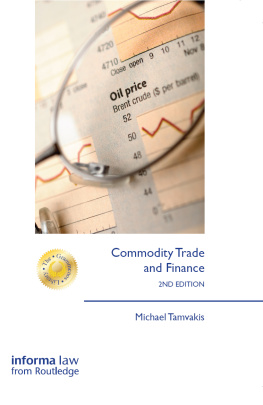All About COMMODITIES
TOM TAULLI


Copyright 2011 by The McGraw-Hill Companies, Inc. All rights reserved. Except as permitted under the United States Copyright Act of 1976, no part of this publication may be reproduced or distributed in any form or by any means, or stored in a database or retrieval system, without the prior written permission of the publisher.
ISBN: 978-0-07-176999-0
MHID: 0-07-176999-4
The material in this eBook also appears in the print version of this title: ISBN: 978-0-07-176998-3, MHID: 0-07-176998-6.
All trademarks are trademarks of their respective owners. Rather than put a trademark symbol after every occurrence of a trademarked name, we use names in an editorial fashion only, and to the benefit of the trademark owner, with no intention of infringement of the trademark. Where such designations appear in this book, they have been printed with initial caps.
McGraw-Hill eBooks are available at special quantity discounts to use as premiums and sales promotions, or for use in corporate training programs. To contact a representative please e-mail us at bulksales@mcgraw-hill.com.
This publication is designed to provide accurate and authoritative information in regard to the subject matter covered. It is sold with the understanding that neither the author nor the publisher is engaged in rendering legal, accounting, securities trading, or other professional services. If legal advice or other expert assistance is required, the services of a competent professional person should be sought.
From a Declaration of Principles Jointly Adopted by a Committee of the American Bar Association and a Committee of Publishers and Associations
Trademarks: McGraw-Hill, the McGraw-Hill Publishing logo, All About, and related trade dress are trademarks or registered trademarks of The McGraw-Hill Companies and/or its affi liates in the United States and other countries and may not be used without written permission. All other trademarks are the property of their respective owners. The McGraw-Hill Companies is not associated with any product or vendor mentioned in this book.
TERMS OF USE
This is a copyrighted work and The McGraw-Hill Companies, Inc. (McGraw-Hill) and its licensors reserve all rights in and to the work. Use of this work is subject to these terms. Except as permitted under the Copyright Act of 1976 and the right to store and retrieve one copy of the work, you may not decompile, disassemble, reverse engineer, reproduce, modify, create derivative works based upon, transmit, distribute, disseminate, sell, publish or sublicense the work or any part of it without McGraw-Hills prior consent. You may use the work for your own noncommercial and personal use; any other use of the work is strictly prohibited. Your right to use the work may be terminated if you fail to comply with these terms.
THE WORK IS PROVIDED AS IS. McGRAW-HILL AND ITS LICENSORS MAKE NO GUARANTEES OR WARRANTIES AS TO THE ACCURACY, ADEQUACY OR COMPLETENESS OF OR RESULTS TO BE OBTAINED FROM USING THE WORK, INCLUDING ANY INFORMATION THAT CAN BE ACCESSED THROUGH THE WORK VIA HYPERLINK OR OTHERWISE, AND EXPRESSLY DISCLAIM ANY WARRANTY, EXPRESS OR IMPLIED, INCLUDING BUT NOT LIMITED TO IMPLIED WARRANTIES OF MERCHANTABILITY OR FITNESS FOR A PARTICULAR PURPOSE. McGraw-Hill and its licensors do not warrant or guarantee that the functions contained in the work will meet your requirements or that its operation will be uninterrupted or error free. Neither McGraw-Hill nor its licensors shall be liable to you or anyone else for any inaccuracy, error or omission, regardless of cause, in the work or for any damages resulting therefrom. McGraw-Hill has no responsibility for the content of any information accessed through the work. Under no circumstances shall McGraw-Hill and/or its licensors be liable for any indirect, incidental, special, punitive, consequential or similar damages that result from the use of or inability to use the work, even if any of them has been advised of the possibility of such damages. This limitation of liability shall apply to any claim or cause whatsoever whether such claim or cause arises in contract, tort or otherwise.
CONTENTS
Chapter 1
Introduction to Commodities Investing
Chapter 2
The Futures Markets
Chapter 3
Understanding Futures Prices
Chapter 4
Futures Trading Strategies
Chapter 5
Options on Futures
Chapter 6
Fundamental Analysis
Chapter 7
Technical Analysis
Chapter 8
Precious Metals
Chapter 9
Energy
Chapter 10
Agriculture
Chapter 11
Industrial Metals
Chapter 12
Livestock and Dairy
Chapter 13
Investing in Miners
Chapter 14
Global Commodities Investing
Chapter 15
Buying Physical Commodities
Chapter 16
Funds
CHAPTER 1
Introduction to Commodities Investing
Key Concepts
Look at the main drivers of commodities prices
Understand the benefits of investing in commodities
Discuss the risks
Commodities are pervasive throughout the world economy. Every day we buy food and energy. We drive our cars, which are made out of an assortment of metals and other materials. We live in homes and apartments, which are also made out of various commodities. Without these valuable materials, civilization would vanish. Its that simple.
On a global basis, commodities markets are massive and trade in trillions of dollars on a daily basis. There is also much diversity. For example, investors can invest in the following categories:
Agriculture: Includes corn, wheat, soybeans, cotton, sugar, cocoa, orange juice, coffee, and oats.
Livestock: Includes live cattle, feeder cattle, pork bellies, and lean hogs.
Precious metals: Includes gold, silver, and platinum.
Industrial metals: Includes copper, palladium, aluminum, tin, nickel, zinc, lead, and cobalt.
Energy: Includes crude oil, unleaded gasoline, natural gas, coal, heating oil, uranium, ethanol, and electric power.
There are also a variety of ways for investors to participate in these markets. For example, these include buying and selling futures and options. There are also exchange-traded funds (ETFs), mutual funds, hedge funds, and managed futures. And yes, you can even buy the physical commodity, such as gold or silver, and put the metals in a vault.
COMMODITY MANIA?
Over the past decade, there has been a major bull market in commodities. In fact, it has become a popular topic on cable business channels like CNBC and even mainstream websites. Perhaps one of the most interesting signs of the fervor is that even criminals are focusing on stealing commodities. For example, copper has seen a spike in thefts. After all, the high prices could mean substantial profits. It also helps that you cannot trace copper back to the source.
Criminals are stealing power lines and cooling pipes. Unfortunately, this poses serious problems to communities. Because of this, law enforcement agencies have been putting more resources into combating this new crime wave. Consider that a criminal was able to extract the copper from an irrigation system in Pinal County, Arizona. There was about $10 million in damages. The theft even ruined a harvest. In 2008, a report from Electrical Safety Foundation International (ESFI) listed over 50,000 incidents of copper theft in the United States. The total damages were $60 million.


